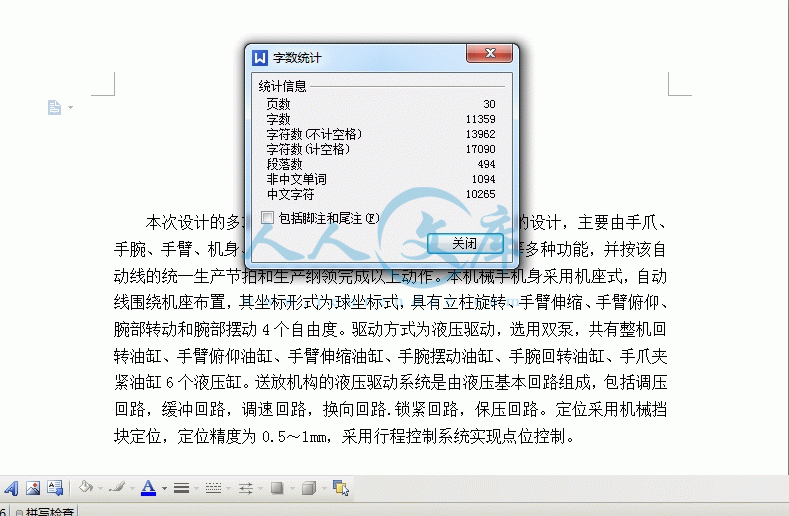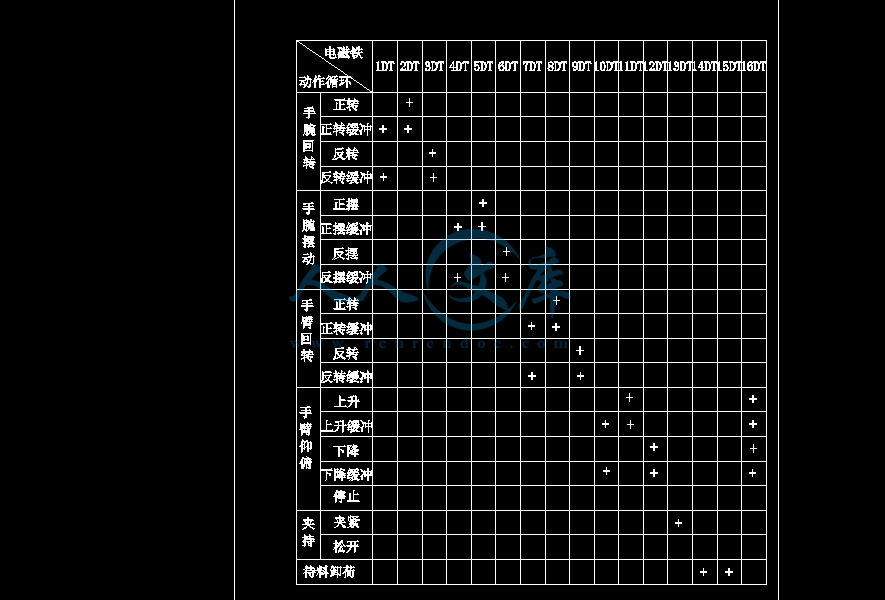汽车零件加工自动线上的多功能机械手的设计【优秀毕业设计】【word+4张CAD图纸全套】
【带任务书+开题报告+答辩资格审查表+答辩及最终成绩评定表+工作中期检查表+指导教师评阅表+实习日记+外文翻译】【30页@正文11300字】【详情如下】【全套设计需要咨询请加QQ1459919609】
任务书.doc
外文文献 2.doc
外文文献原文.pdf
工作进度检查表.doc
开题报告.doc
手臂和腕部结构A0.dwg
手部结构图A1.dwg
指导教师评阅表.doc
液压系统原理图.A1dwg1.dwg
答辩及最终成绩评定表.doc
答辩资格审查表.doc
表格.doc
装配图A0.dwg
评阅教师评阅表.doc
说明书.doc
任务书
课题名称汽车零件加工自动线上的多功能机械手的设计
内容及任务
本课题为汽车零件加工自动线的辅助装置之一,机械手在零件加工自动线上完成上料、转位和翻转等多种功能。
2、设计内容
(1)机械手的总装图,
(2)部件装配图及零件图,
(3)机械手液压系统工作原理图;
(4)设计计算说明书:1份
(所有图纸折合不得少于3张A0图)
拟达到的要求或技术指标1、设计(论文)基本要求
(1)材料牌号,形位公差,粗糙度,图纸的标题栏及明细表都宜采用新图标。
(2)设计应以独立完成为主,图纸表达要正确清晰,计算正确,能借助各种工具书和技术资料获得所需的正确数据。
(3)说明书应内容完整,字迹工整,语言简练,文字通顺。说明书中应重点包括设计方案的分析与论证,考虑问题的出发点和最后选择的依据,必要的计算过程,其他说明等
2、主要技术指标:
(1)最大抓取重量:15Kg;
(2)工件最大尺寸(长×宽×高)250×170×140mm
(3)最大操作范围:提升高度1.5m;回转半径1m;行走范围≤30m;
(4)机械手的自由度:4~5个;
(5)定位精度:0.5~1mm;
(6)装料高度:1050mm;输送轨道宽度:350mm;输送速度:20m/min
(7)生产纲领:10万件/年;生产节拍:3min/件;
(8)性能要求:抓取灵活,送放平稳,安全可靠,寿命不低于15年。
进度安排起止日期工作内容备注
第2~5周毕业调研及实习、搜集设计的相关资料,写出开题报告
第6~8周设计方案的确定
第9~11周完成部件装配图及零件图的绘制
第12~15周编写设计计算说明书, 通过指导老师验收,准备答辩
第16周毕业答辩
主要参考资料[1] 刘心治主编.冷冲压工艺及模具设计[M].重庆:重庆大学出版社,2006.5~10
[2] 模具制造手册 编写组.模具制造手册[J].北京:机械工业出版社,1990.2
[3] 工程材料及机械制造基础 系列教材编写委员会.机械工程材料基础[M].湖南:中南大学出版社,1995,13~47
[4] 刘守勇主编.机械制造工艺与机床夹具[M].北京:机械工业出版社,1995.55~56
[5] 章跃主编.机械制造工程专业英语[M].北京:机械工业出版社,2005.77~78
[6] 甘永立主编.几何量公差与检测[M].上海:科学技术出版社,2005.12~13
[7] 吴宗泽主编.机械设计手册[J](上册 下册).北京:机械工业出版社,1998.99~105
[8] 杨恢先,黄辉先等编著.单片机原理及应用[M].长沙:国防科技大学出版社,2003
[9] 何永然,唐增宝,刘安俊主编.机械设计课程设计(第二版)[M].武汉:
华中科技大学出版社,2002. 58~88
[10] 周良德,朱泗芳等编著.现在工程图学[M].长沙:湖南科学技术出版社,2000
[11] 华中理工大学等院校编,画法几何及机械制图[M].北京:高等教育出版社,2003
[12] 冯炳尧,韩泰荣,殷振海,蒋文森编.模具设计与制造简明手册[J].上海:
上海科学技术出版社,1992. 108~120
[13] 冲模设计手册 编写组.冲模设计手册[J].北京:机械工业出版社,1988.14~15
[14] 王卫卫主编.材料成形设备[M].北京:机械工业出版社,2004.49~50
摘 要
本次设计的多功能机械手用于汽车零件加工自动线上的设计,主要由手爪、手腕、手臂、机身、机座等组成,具备上料、翻转和转位等多种功能,并按该自动线的统一生产节拍和生产纲领完成以上动作。本机械手机身采用机座式,自动线围绕机座布置,其坐标形式为球坐标式,具有立柱旋转、手臂伸缩、手臂俯仰、腕部转动和腕部摆动4个自由度。驱动方式为液压驱动,选用双泵,共有整机回转油缸、手臂俯仰油缸、手臂伸缩油缸、手腕摆动油缸、手腕回转油缸、手爪夹紧油缸6个液压缸。送放机构的液压驱动系统是由液压基本回路组成,包括调压回路,缓冲回路,调速回路,换向回路.锁紧回路,保压回路。定位采用机械挡块定位,定位精度为0.5~1mm,采用行程控制系统实现点位控制。
关键词: 机械手,自动线,液压,设计 ,点位控制
ABSTRACT
The current design of multifunctional mechanical hand used for R175-type diesel organisms automatic processing line, mainly consist of claw, wrists, arms, body, base and so on. With moving the materials, turnover and transfer spaces, and many other functions, the automatic line with the unified production rhythms and production program completed more moves. With the automatic production line rhythms and the production of complete reunification of the above movements, automatic line is around the machine arrange, the coordinates of the ball coordinates of the form, with huge rotary, extendable arm, arm pitch, hitting and hitting back five moves freedom; Driven approach to hydraulic-driven, and the choice of double leaves pumps, the system pressure to 2.5MPa, 5.5KW electrical power for a total of whole sets of rotation tank, arm tilt cylinders, fuel tanks extendable arm, wrist swing tank, wrist rotation tank, claw clip tank six hydraulic oil tank; positioning a piece of machinery turned positioning, positioning accuracy for 0.5~1mm, using control systems to achieve their point spaces control.
Key words: Mechanical hand, the ball coordinates, hydraulic, mechanical turned pieces, control point spaces
目 录
1绪论1
1.1机械手的概述1
1.2机械手的组成与分类1
1.2.1机械手的组成1
1.3机械手的分类2
1.3 机械手的组成3
2总体方案分析4
2.1总体方案分析4
2.2方案的确定4
2.3动作原理4
2.4 主要技术指标5
3手部的设计6
3.1手部结构6
3.2手爪的计算与分析6
3.2.1手爪执行液压缸工作压力计算6
3.2.2 手爪的夹持误差分析与计算7
4腕部的设计8
4.1腕部结构8
4.2 腕部回转力矩的计算8
5手臂的设计11
5.1手臂伸缩液压缸的设计计算11
5.1.1手臂作水平伸缩直线运动驱动力的计算11
5.1.2手臂垂直升降运动驱动力的计算11
5.1.3确定液压缸的结构尺寸12
5.1.4液压缸壁厚计算12
5.1.5活塞杆的计算13
5.1.6液压缸端盖的联接方式与强度计算13
5.1.6缸盖螺钉计算13
5.1.7缸体螺纹计算14
5.2手臂俯仰运动的设计计算15
5.2.1手臂俯仰时所需的驱动力矩15
5.2.2缸盖联接螺钉计算和动片联接螺钉计算16
5.2.3动片联接螺钉的计算16
6.机身设计18
6.1机身结构的计算18
6.2机身设计时应注意的事项19
7机械手液压系统的工作原理20
7.1液压系统的组成20
7.2液压传动系统机械手的特点20
7.3油缸泄漏问题与密封装置20
7.3.1活塞式油缸的泄漏与密封21
7.3.2回转油缸的泄漏与密封21
7.4液压系统传动方案的确定22
7.4.1各液压缸的换向回路22
7.4.2调整方案22
7.4.3减速缓冲回路22
7.4.4系统安全可靠性23
参考文献25
致 谢26
1绪论
1.1机械手的概述
工业机械手(以下简称机械手)是近代自动控制领域中出现的一项新技术,作为多学科融合的边沿学科,它是当今高技能发展速度最快的领域之一,并已经成为现代机械制造生产系统中的一个重要组成部分。
所谓工业枢机手就是一种能按给定的程序或要求自动完成物件(如材料、工件、零件或工具等)传送或操作作业的机械装置,它能部分地代替人的手工劳作。较高级型式的机械手,还能模拟人的手臂动作,完成较复杂的作业。
1.2机械手的组成与分类
1.2.1机械手的组成
工业机械手是由执行机构、驱动系统和控制系统所组成,各部关系如图1所示:
图1 工业机械手组成图框
机械手大致可分为手部、传送机构、驱动部分、控制部分以及其他部分。
手部(或称抓取机构)包括手指、传力机构等.主要起抓取和放置物件的作用;
传送机构(或称臂部)包括手腕、手臂等.主要起改变物件方向和位置的作用;
驱动部分 它是驱动前两部分的动力.因此也称动力源,常用的有液压、气压、电力和机械式驱动等四种形式;
控制部分 它是机械手动作的指挥系统.它来控制动作的顺序(程序)、位置和时间(甚至速度与加速度)等;
其它部分 如机体、行走机构、行程检测装置和传感装置等。
1.3机械手的分类
机械手从使用范围、运动坐标形式、驱动方式以及臂力大小四个方面的分类分别为:
(1)按机械手的使用范围分类:
1)专用机械手
一般只有固定的程序,而无单独的控制系统。它从属于某种机器或生产线用以自动传送物件或操作某一工具,例如“毛胚上下料机械手”、“曲拐自动车床机械手”、“油泵凸轮轴自动线机械手”等等。这种机械手结构较简单,成本较低,适用于动作比较简单的大批量生产的场合。
2) 通用机械手(也称工业机器人)
指具有可变程序和单独驱动的控制系统,不从属于某种机器,而且能自动生成传送物件或操作某些工具的机械装置。通用机械手按其定位和控制方式的不同,可以分为简易型和伺服型两种。简易型只是点位控制,故属于程序控制类型,伺服型可以是点位控制,也可以是连续轨迹控制,一般属于数字控制类型。这种机械手由于手指可以更换(或可调节),程序可变,故适用于中、小批生产。但因其运动较多,结构复杂,技术条件要求较高,故制造成本一般也较高。
按机械手臂部的运动坐标型式分类:
1)直角坐标式机械手
臂部可以沿直角坐标系X、Y、Z三个方向移动,亦即臂部可以前后伸缩(定为沿X方向移动)、左右移动(定为沿Y方向移动)和上下升降(定为沿Z方向的移动);
参考文献
[1]李允文.工业机械手设计[M].北京.机械工业出版社,1994.
[2]徐灏.机械设计手册第五卷[M].北京.机械工业出版社,1992.
[3]沈鸿.机械设计手册第十卷[M].北京.机械出版社,1982.
[4]孟宪源.现代机构手册下册[M].北京.机械工业出版社,1994.
[5]吴振彪.工业机器人.武汉[M].华中科技大学出版社,2000.
[6]左健民.液压与气压传动[M].武汉华中科技大学出版社,1992.
[7]陈启松.液压传动与控制手册[M].上海.上海科技大学出版社,2006.
[8]刘军营.液压与气压传动.西安[M].西安电子科技大学出版社,2007.
[9]吴卫荣.液压技术[M].北京中国轻工业出版社,2006
[10]张世亮.液压与气压传动[M].北京.机械工业出版社,2006.
[11]雷天觉.液压工程手册[M].北京.机械工业出版社,1990.
[12]廖常初.可编程序控制器的编程方法与工程应用[M].重庆大学出,2000.
[13]王守城、段俊勇.液压元件及选用[M].北京.化学工业出版社,2007
[14]黄继昌,徐巧鱼.现代机构图册[M].北京.机械工业出版社,2008
[15]李天元.简明机械工程手册[M].云南.云南科技出版社,1998.
[16]何国金.机械电气自动控制[M].重庆.重庆大学出版社,2002.
[17]谢忠安.自动控制系统[M].重庆.重庆大学出版社,2003.
[18]纪名刚.机械设计[M].北京.高等教育出版社,2000.
[19]袁子荣.液压与气压控制技术基础[M].重庆.重庆大学出版社,2005
[20]唐仲文.机电一体化技术应用实例[M].北京.机械工业出版社,1994.







 川公网安备: 51019002004831号
川公网安备: 51019002004831号